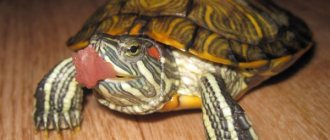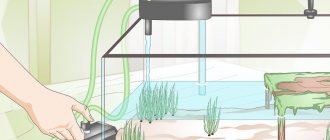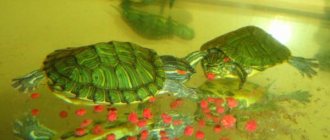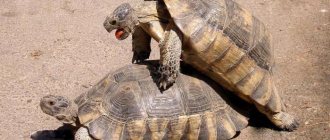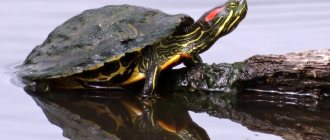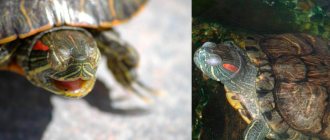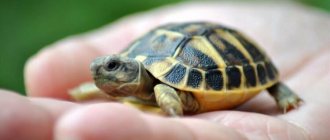Swamp turtle in its natural habitat
The habitat of marsh turtles is unusually wide. Any pond or river with standing water is an excellent home for these amphibians. The life of swamp turtles is simple and measured, since any pond with stagnant water is full of fry, insects, tadpoles, worms, as well as algae, which the turtle feeds on throughout the summer season. Summer is a very important period for a turtle, since at this time the amphibian needs to lay several clutches of eggs and accumulate a significant amount of fat reserves, which will be sufficient to maintain the animal’s life while it is in hibernation.
Causes
Unfortunately, only 2% of turtles die from old age when kept at home. In older reptiles, the body gradually ages, as a result of which the pet turtle dies from chronic systemic diseases. Much more often, the causes of death of exotic animals at home are:
- improper maintenance of the reptile;
- unbalanced diet;
- lack of vitamins and mineral elements;
- violation of the conditions of transportation or keeping in a pet store;
- congenital pathologies;
- overfeeding;
- infectious and non-communicable diseases;
- decreased immunity.
Congenital developmental disorders or decreased immunity are criteria for natural selection; animals with such developmental defects most often die in the first month of life. 40% of the causes of turtle deaths are due to violation of feeding and keeping conditions at home, 48% due to negligent treatment of animals during transportation and storage in pet stores. Very often, people purchase an already sick, exhausted reptile that has no chance of survival.
The first wintering of a marsh turtle
Surprisingly, little turtles go into their first winter hibernation immediately after birth, without ever leaving their nest. The thing is that the habitat of swamp turtles is often not pleasant in the long summer, so warm days are only enough for small turtles buried deep in the sand to form in their shells. Reptile eggs are completely dependent on the sun, so warm days are only enough for the turtles to hatch, since the incubation period ranges from 54 to 90 days, depending on the ambient temperature.
Turtles hatch in mid-autumn, when it is already starting to get colder and there is not enough food for them, so they do not leave their underground nest, hibernating where they emerged from the shell. Turtles do not have stored fat, but they have large sacs of yolk on their abdomens, which help them survive the winter cold while hibernating. Newborn turtles are literally frozen in their nests, but when spring arrives, they wait again and emerge into sunlight for the first time.
Signs of hibernation
The state of wintering is often confused with death. To put your mind at ease, check your red-eared slider for several points that will help you understand that it is definitely hibernating:
- Jaws. Try to pull your lower jaw down and leave your mouth open. The reptile should try to close its jaws.
- Eyes. A cold metal spoon placed against your pet's eye should trigger the corneal reflex. If the turtle tries to retract the disturbed organ or opens its eyelids, then there is no reason to worry.
- Reaction to heat. A hibernating red-eared turtle placed in a container of warm water (30°C) will begin to move its paws.
Otherwise, signs of hibernation include:
- Decreased activity. The pet behaves lethargically, hides in a corner of the aquarium, remaining motionless, and refuses to leave its house for a walk.
- Poor appetite. In addition to loss of activity, the reptile refuses its favorite food and reduces its usual amount of food.
- Increased sleep duration. Long periods of rest are accompanied by frequent yawning.
Overwintering device for an adult turtle
A decrease in ambient temperature in September-October is the main signal for turtles that it is time to prepare for hibernation. By this time, the turtles are already fully prepared for such a change and have stocked up on the necessary amount of fat. For the winter, most swamp turtles sink to the bottom of the reservoir and bury themselves deep in the mud. The temperature of the mud where the turtles hide does not fall below 3-5 °C, so adult turtles do not freeze completely.
In dense mud, the turtle hibernates, stops breathing, and slows down its heartbeat and metabolism. The turtle spends the entire winter in this state, waking up only when the water temperature rises to +5-7°C. In rare cases, marsh turtles hide for the winter in dug burrows on steep banks near a pond, but such cases are extremely rare and are observed mainly in reservoirs where the silt layer is insufficient for wintering turtles.
Rules for caring for a sleeping turtle
If you notice the first signs of the approaching winter in a red-eared slider, be sure to consult with a veterinarian, who will examine it and tell you what needs to be done if the reptile actually hibernates.
During the winter, adhere to the following recommendations:
- Lower the water level
. The turtle burrows into the ground, where it can sleep for a long time without rising to the surface. Oxygen is obtained by special membranes in the cloaca and oral cavity. - Turn off additional lighting
. The pet will have to go to the bottom to maintain warmth, so turn off the filtration and monitor the water level. Excessive movement will destroy the thermal layer, and a low water level will lead to freezing to the very bottom. - Avoid feeding
. Thanks to slow digestion, the turtle digests the food eaten the day before over the course of several months. - Monitor your pet's well-being
. Domestic turtles fall asleep as early as November, when daylight hours begin to shorten, and sleep for about 4 months. It happens that the reptile does not wake up even in February. In this case, you have to wake up the pet yourself.
If the turtle looks active or it is February, then gradually increase the temperature and light to normal. The recovery period takes from 5 to 7 days.
You can feed your pet only after returning to normal activity, but not earlier than the 5th day.
Description
The length of the carapace of males is 14-17 cm, and that of females is 16-20 cm. Their weight, respectively, reaches 400-700 g and 800-1000 g. Males have longer and sharper claws.
The convex olive-brown carapace is covered with smooth horny scutes. The plastron is decorated with relatively large light spots. In males, the central part of the plastron is slightly concave inward.
There are many small yellowish spots on the head, neck and limbs. There are completely black and spotless individuals.
The pupils of the eyes are round. Males have predominantly red-orange or brown irises, while females have yellow irises. Between the toes there are swimming membranes.
The lifespan of the European marsh turtle is 50-70 years. In captivity, some record holders live to reach their centenary.
Awakening
A few words about how to bring a red-eared turtle out of hibernation. If conditions are good, then the duration of hibernation is 3-5 months. You cannot feed the animal immediately after waking up; you need to wait until its digestive system starts working. Wash the animal in warm water, this will speed up the awakening process. You can't let hibernation be too long. Gradually increase the temperature of the reptile, thereby stimulating the awakening process. If you do not do this, the animal may become completely weak.
Hibernation is a completely natural process for turtles living in nature, but for indoor pets, wintering is often not relevant. This is a rather complicated procedure and a huge burden on the turtle’s body, so it is not recommended to hibernate turtles on your own, only under the supervision of a specialist.
The first signs that it is time for the animal to winter can be observed in late October - early November. The turtle becomes less active, its appetite decreases, it tries to bury itself in the ground or almost never leaves its shelter. In the natural environment, hibernation lasts from 3 to 5 months, all vital processes of the body slow down, and accumulated resources are used to maintain life. There are also advantages to wintering: it is indicated for turtles from which the owners plan to get offspring, since hormonal levels are adjusted, life expectancy increases, and the activity of the internal glands is maintained.
It is worth remembering that under artificial conditions hibernation should not be so long: for small breeds it is 8-10 weeks, for large breeds it is 12-14. The animal must be absolutely healthy, and a suitable microclimate must be maintained constantly, otherwise the turtle may not emerge from hibernation. If you are not confident in your abilities, it is easier to maintain normal conditions: temperature at 27-28 degrees, frequent bathing, good nutrition. Does your turtle eat well? – go to the clinic, a specialist will give her an injection of vitamins.
Nutrition
This species is an omnivore, but more than 70% of its diet consists of food of animal origin. Adult animals are more inclined towards vegetarianism and in some regions up to 90% of the food they eat consists of aquatic plants.
The reptile readily eats various insects, tadpoles, various crustaceans, fish and mollusks. The menu is varied with arrowhead, water iris, duckweed and hyacinths.
We suggest you read: Is it possible to give beans to cats - benefits and harm?
Almost always, eating food occurs in water, since these reptiles need liquid to swallow it. In captivity, they are fed worms, grasshoppers, ant larvae, freshwater fish and aquarium fish food.
Natural enemies
Red-eared turtles have a lot of ill-wishers in the wild. They are often hunted by alligators, raccoons, foxes, opossums and raptors.
For the younger generation, the main threat is from predatory fish and birds. There are also many who want to feast on their laid eggs. Clutches often fall prey to feral dogs.
For the purpose of self-defense, she bites and scratches the offender, but most often she simply hides under her shell.
Prevention
To prevent pests from appearing, it is necessary to regularly carry out preventive measures:
- The use of planting material of varieties that are quite resistant to infection by harmful insects;
- Fertilizing the soil with preparations containing potassium and phosphorus;
- Constant weed control;
- Planting shelterbelts or areas of abundant vegetation near fields. The enemies of harmful turtles will settle in them: beetles, ants, spiders and birds;
- On a small domestic scale, bedbugs are fought with the help of chickens. Each chicken destroys 1,500 parasites per day;
- Timely collection of ripe harvest. A combine is used for this.
What to do with turtle bugs:
For humans, bugs are not dangerous, but for agriculture they are a big and serious threat. Knowing its appearance, the characteristics of its behavior, what ways to fight them, as well as taking the necessary preventive measures, all this will allow them to be completely destroyed. Integrated control will help preserve the harvest.
With proper care, the marsh turtle is practically not susceptible to disease. A reptile can contract the following diseases:
1. Pneumonia - pets living in colder water than necessary are susceptible to the disease. Lack of heating and additional lighting contribute to the development of this dangerous disease.
Symptoms of the disease are as follows: the turtle spends more time in a dry area, even refuses its favorite food, sputum may be released from the nose and mouth, and dry out with a white crust. The turtle will not swim as actively; it often falls to the side of the affected lung. Often turtles will begin to cough and sneeze, rubbing their heads with their front paws in hopes of clearing their airways.
If such symptoms appear, you need to urgently show the animal to a veterinarian, because the disease can cause asphyxia and then death. The doctor will prescribe treatment with antibiotics, without which pneumonia cannot be treated. It will also be necessary to increase the temperature in the terrarium on the dry part to +35 degrees, turn on the ultraviolet in the same way as before the disease.
2. Rickets - this disease develops in turtles with a lack of vitamin D and calcium. There is a lot of vitamin in sunlight, and ultraviolet lamp helps produce calcium.
Symptoms: the shell begins to grow pyramidally, it seems that it is too small for the turtle, and does not harden until it is a year old. The edges of the shell may begin to curl upward. The animal's limbs become twisted and fractures may occur. Weakness is observed in which the turtle will not be able to get out of the water onto land. Rickets is dangerous for a turtle due to pulmonary edema and heart failure, which leads to death. When the first symptoms appear, visit your doctor.
3. Helminthiasis - many turtles that are fed freshwater fish are susceptible to the disease.
Symptoms: see the parasites in person, the turtle refuses food or regurgitates it, becomes overly active.
4. Fungal skin lesions, eye inflammation. All these diseases threaten the turtle if the terrarium is not kept clean. Your pet's skin will crack and bleed, causing pain. The turtle's eyes will begin to discharge, drying around the edges.
The first step is to wash the turtle in a basin of boiled (cooled) clean water, adding a little manganese. Completely remove all water and sand from the terrarium, rinse the stones in water with manganese. Next, wash the walls of the terrarium, fill it with clean water and turn on the ultraviolet lamp for 15 minutes. Only a veterinarian can prescribe treatment for damaged skin and eyes!
Among other things, turtles are exposed to various injuries to the shell, limbs, and tail. The cause of injury may be a lack of calcium or a fall. If you notice something strange in your pet's behavior, take her to the vet immediately!
Preparation
In the fall, when the turtle is about to hibernate, it begins to eat less, no need to be surprised. Metabolism in turtles is truly “turtle-like”, the activity of the digestive system slows down, the body digests food within 2-4 weeks.
There is no need to hibernate your turtle if there is undigested food left in its intestines. The gases that are released can cause serious harm to the health of the turtle. If you notice that the reptile has become slow and inactive, stop feeding it; for it, hunger is better than feeding during this period. The ambient temperature can be reduced slightly and the daylight hours can be shortened.
But 2 months before hibernation, the turtle needs to be well fed so that it can accumulate enough nutrients and useful substances in its body. After all, during wintering the reptile loses up to 50% of its weight.
Warm baths, which can be done for the turtle 1-2 days before hibernation, will help activate digestion. During bathing, it will be saturated with water, since it has the ability to absorb water through the skin, and will get rid of food debris in the intestines.
On the eve of hibernation, the turtle should be healthy and of normal weight. If the weight and general condition of the animal cause you concern, you should not artificially hibernate it. And if she falls asleep on her own, keep her in a warm and dry terrarium with good ventilation.
In nature, a turtle hibernates by burying itself in sand or silt; you should try to create the same conditions for it at home. It is not necessary to take the mud home, but dry, clean sand in a box will do just fine. Fallen leaves or moss will be a good material for our purposes; thanks to them, the terrarium will have normal temperature and air humidity.
You can do without sand and leaves if you put small pieces of paper in the box. Newspaper is not suitable for these purposes - it contains harmful printing ink. The box with the sleeping turtle should be kept in a dry room with above-zero temperatures.
It is advisable to maintain the temperature during hibernation at the same level, within +5-6 degrees. Temperatures from +2 to +10 degrees Celsius are allowed. If you keep a sleeping turtle for a long time at a temperature of +2 and below, or +10 and above, it can become seriously ill or die.
The duration of wintering depends on the size - for small turtles, 3-3.5 months will be enough for hibernation. The red-eared slider spends 4-5 months in hibernation.
Spreading
Red-eared turtles are common in North and Central America. The largest populations live in Mexico, Nicaragua, Panama, Guatemala, Honduras, Venezuela and the United States.
They inhabit fresh water bodies with standing or slowly flowing water and a muddy bottom. An important condition for their comfortable living is the presence of abundant vegetation along the banks and convenient places for sunbathing. Reptiles love to climb trees lying in ponds and, sitting on them, bask in the sun for a long time.
Currently, 15 subspecies are known, of which three are considered the most common among breeders - Ts scripta, Ts elegans and Ts troosti. They all live in the USA.
Pleasant awakening
Coming out of hibernation is an important moment in the life of a turtle, and it needs help to cope with this task. How to bring a turtle out of hibernation? All autumn reserves are used up, the turtle wakes up weak, exhausted and vulnerable to infections. At this moment, she needs care and quality nutrition more than ever.
After the turtle comes out of hibernation, it is warmed with a lamp or fan heater, then a “bath day” is arranged - in a small container with warm water. The turtle should bathe for about 10 minutes, this will restore the water balance in its body.
After hibernation, water procedures must be repeated every day for a week. They can be stopped when the reptile urinates for the first time. At first, her urine will be thick and dark yellow, but gradually the toxins will come out and it will become light in color again.
Now you can “sit down at the table,” of course, if its appetite has awakened along with the turtle. At first, the reptile may refuse food, this is normal, gradually everything will recover.
What signs can be used to determine that a turtle has safely emerged from hibernation? A healthy reptile's tongue will be pink or orange, without a coating. If it is bright red, the animal may be infected with something. The eyes should be clear and clean, also without plaque or discharge.
Hibernation is a completely natural process for turtles living in nature, but for indoor pets, wintering is often not relevant. This is a rather complicated procedure and a huge burden on the turtle’s body, so it is not recommended to hibernate turtles on your own, only under the supervision of a specialist.
The first signs that it is time for the animal to winter can be observed in late October - early November. The turtle becomes less active, its appetite decreases, it tries to bury itself in the ground or almost never leaves its shelter. In the natural environment, hibernation lasts from 3 to 5 months, all vital processes of the body slow down, and accumulated resources are used to maintain life. There are also advantages to wintering: it is indicated for turtles from which the owners plan to get offspring, since hormonal levels are adjusted, life expectancy increases, and the activity of the internal glands is maintained.
It is worth remembering that under artificial conditions hibernation should not be so long: for small breeds it is 8-10 weeks, for large breeds it is 12-14. The animal must be absolutely healthy, and a suitable microclimate must be maintained constantly, otherwise the turtle may not emerge from hibernation. If you are not confident in your abilities, it is easier to maintain normal conditions: temperature at 27-28 degrees, frequent bathing, good nutrition. Does your turtle eat well? – go to the clinic, a specialist will give her an injection of vitamins.
A red-eared slider from the USA attacked water bodies in Moscow and the Moscow region
Alexander Zhirnov
The red-eared turtle (Trachemys scripta elegans), a characteristic inhabitant of freshwater bodies of North America, thanks to human negligence and good adaptability to various natural conditions, is actively settling in rivers and ponds of the Moscow region. Experts have long been saying that this species of reptile is a real invasive threat to central Russia.
Red-eared turtles, as it turned out, do not find it difficult to exist in Russian cold conditions due to their unique ability for long-term anaerobic existence at very low temperatures. Animals can sleep for three months, burrowing into the silt at the bottom of frozen bodies of water. They are fertile, mobile, omnivorous and enter sexual maturity early.
Russian ponds and rivers have been attacked by overseas guests in recent years due to the fact that they were turned out of the door by their previous owners - people who bought small, cute turtles, but later did not want to take care of large, not very fragrant and voracious pets. In indoor conditions, an adult red-eared slider requires an aquarium with a volume of 100 liters and enhanced nutrition. These reptiles usually live up to 40 years. All this makes them not very desirable in city apartments.
Few gullible buyers at bird markets know that the International Union for Conservation of Nature has included the red-eared turtle in the top hundred invasively dangerous plants and animals. In the United States, the invasion of these “cuties” was encountered after the end of World War II, when the demand for pets increased sharply. By 1996, their exports from the United States reached eight million. Israeli environmentalists were the first to sound the alarm. Red-eared animals have already occupied the territory of Spain, Italy and France and continue to actively expand their range to the north and east of Europe, displacing local species. Rare aquatic plants, almost all amphibians, aquatic insect larvae, and endangered aquatic and semi-aquatic invertebrate animals that are important for the functioning of ecosystems are under threat. The situation becomes especially acute in urban environments, where local organisms exist literally on the brink of survival. But this is where the red-eared turtle invasion begins.
Another danger is the ability of the red-eared turtle to spread a dangerous disease - salmonellosis, which is why the number of farms breeding these animals has long been reduced in the United States. Many European countries already have a range of measures in place to prevent the further spread of Trachemys scripta elegans. The European Union has introduced a complete ban on trade in this species.
In Moscow, in the last decade, there have been more and more cases of detection of the red-eared turtle. At first, environmentalists believed that she could not survive in the Russian cold, but practice has shown that this is not so. They are regularly found in the Tsaritsyn and Kuzminsky ponds, Yauza, Chermyanka, Mars and Dzhamgarovsky ponds, as well as in the Altufevskaya River. This year, Muscovites noticed American invaders in the Vorontsovsky and Chernevsky ponds.
How long does the red ear live and where does it live?
This type of turtle can rightfully be considered a long-liver. In favorable conditions, life expectancy is 40 years. An interesting fact is that the red-eared turtle has a high level of intelligence, not typical of other reptiles. These animals are very sensitive to vibrations and their behavior can warn of an impending earthquake or storm. When choosing food, the red-eared turtle first focuses on the color, and only then on the smell and taste of the object.
These reptiles are widespread in nature. They can be found in their natural environment in Central and South America, Israel, South Africa, Spain and even Great Britain. But in Australia, this species is officially recognized as a pest, since it destroys local endemics. The red ear lives in shallow ponds and lakes, and in other bodies of water with swampy shores.
Keeping this exotic animal turns out to be much more difficult than initially thought. These turtles spend most of their time in the water, although they need land. For one adult, an aquaterrarium with a volume of 120-150 liters will be comfortable, while land should occupy no more than 25% of the total area. On the improvised bank, special soil or crushed stone should be poured, making a gentle rise. The turtle's shell must fit completely in the water so that the animal can easily roll over onto its back and back.
For this type of amphibian, the optimal temperature is 25-30 degrees Celsius. When the temperature drops to 20 degrees, hibernation may occur in red-eared turtles. The water in the aquarium is changed as needed, at least once a month. In order for the turtle to be healthy, it also needs to be provided with portioned irradiation with an ultraviolet lamp.
